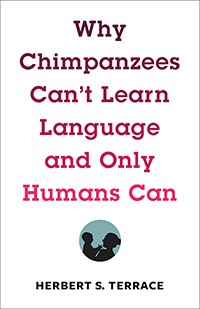Project Nim Revisited
Forty years later, a Columbia professor shares what he learned from a high-profile experiment in which he tried to teach a chimp human language.
In 1973, Herbert Terrace set out to do what no researcher had accomplished: to teach a chimpanzee to use simple aspects of language.
Terrace arranged to have an infant chimp – named Nim Chimpsky, a poke at linguist Noam Chomsky, whose theories he challenged – cared for by a family not far from Columbia’s Morningside campus. Over three years, Terrace and a group of students and caregivers trained Nim to express himself in American Sign Language.
Nim learned 128 signs and, more impressive, produced sequences of signs. But, ultimately, Terrace discovered that chimpanzees were incapable of learning language. “Nim learned to sign to obtain food, drink, hugs and other physical rewards,” said Terrace, a professor of psychology at Columbia University since 1961 and director of the Department of Psychology’s Primate Cognition Lab.
“Nim often got the signs right, but that was because his teachers inadvertently prompted him by making appropriate signs a fraction of a second before he did. Nim’s signing wasn’t spontaneous,” Terrace said. “He was unable to use words conversationally, let alone form sentences.”
Terrace wrote up his findings in the journal Science and moved on to other primate research.
But controversy over Project Nim continued long after the experiment – with questions raised about scientific objectivity and ethics – spawning articles, books and a 2011 documentary.

Nim, who died in 2000 at age 27 at a Texas animal sanctuary, has largely faded from public consciousness. But for Terrace, the experiment has had a lifelong impact, propelling him to spend the next 30 years trying to understand why humans can learn language and apes, who share 99 percent of our DNA, cannot.
Columbia News talked with Terrace about his new book, Why Chimpanzees Can’t Learn Language and Only Humans Can, (Columbia University Press), in which he revisits the Nim project and its impact on his life and work.
Q. Why a book about Project Nim now?
A. It took me many years to discover the positive implications of Project Nim. While some have described the experiment as a “failure,” I don’t think the term is accurate. There is a big difference between negative findings and failure, and I believe it is important to educate the public that negative results can inspire questions that can move science forward. Knowing that chimpanzees couldn’t learn language spurred me to delve deeper into the mystery of how language evolved, for which scientists still do not have answers. I immersed myself in research by developmental psychologists that led me to a new approach to the origin of language.
Q. What are some of your key conclusions about the differences between the brains of humans and apes and how language evolved?
A. Chimpanzees can't learn language because they can't learn that things have names, an ability that infants display by the time they are 12 months. Developmental psychologists have shown that infants and mothers experience two remarkable interactions that distinguish their history from that of every other primate. Infants are the least developed of all primates. Their brain and nervous system are roughly 25 percent of their adult size; in chimpanzees, it is 45 percent. Because of their lack of mobility, infants must be cradled for the first six months of life. An important benefit of cradling is the proximity of the infant's and the mother's eyes – a precursor to their ability to observe and anticipate each other's behavior.
The second interaction begins at about 6 months, when an infant begins to crawl and manipulate objects. Often, she engages her mother by pointing to an object or by holding it up to her; the mother typically responds by looking back and smiling. That confirms that they shared attention to the same object. Sharing attention makes it easy for the infant to learn the object’s name, the first step in acquiring language.
Q. How do your theories differ from Noam Chomsky, who also holds that humans are the only species wired for language?
A. Chomsky focused on grammar as the most distinctive feature of our language. He theorized that a "universal grammar," embedded in the neuronal circuitry of the human brain, could generate sentences in any of the 6,000 languages that people speak. He also showed that grammar allows one to create an innumerably large number of meanings from a finite number of words. Those insights had a profound effect on linguistics and cognitive psychology. But they said nothing about words, without which none of his grammars would work. At best, Chomsky's theories are limited to people who know words. Project Nim showed why learning words is crucial for mastering language.
Q. Why is it important for us to understand language? Why should people read your book?
A. Language is special because it differs from animal communication in two respects. It allows humans to name things and to create new meanings by recombining words. No animal has those abilities. This book offers a theory of language that emphasizes words and conversation over grammar, which deepens our understanding of the basic differences between the minds of humans and apes.
